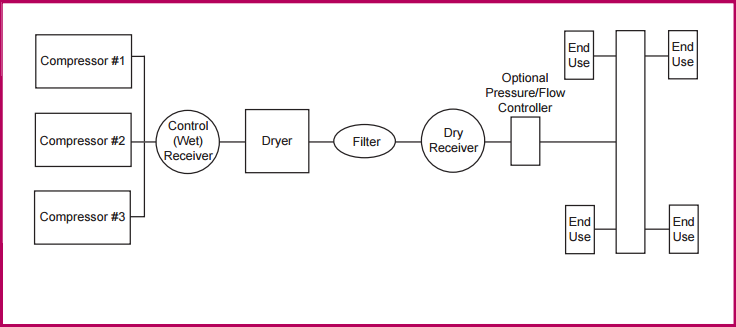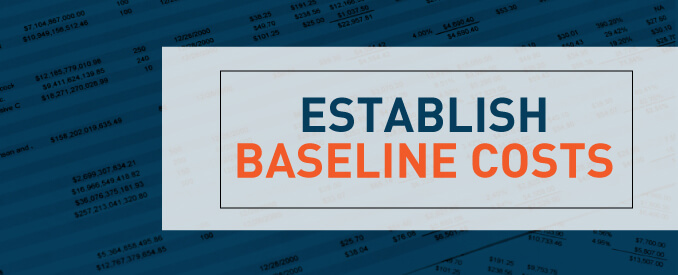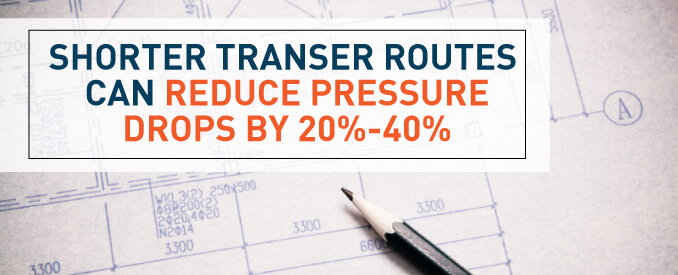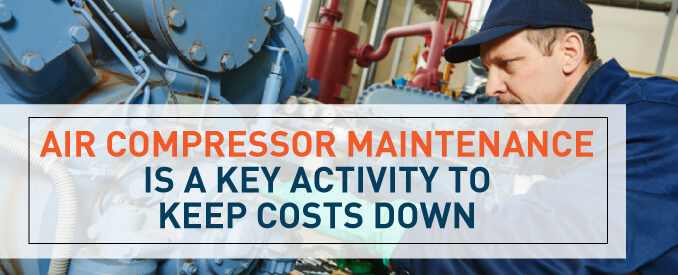
7 Steps to Save Money and Energy with Your Compressed Air System
In today’s competitive world, cost control is the key factor to turning a profit. Air compressors can blow away money from your production budget if they are not properly maintained.
Leaks and worn parts reduce the pressure your compressor can produce. Worn seals and cracked connectors can fail unexpectedly, creating blow outs. Unplanned downtime costs money in lost production or emergency equipment hire, and physical damage and personal injury claims will pile on the costs of a faulty air compressor.
Preventative air compressor maintenance is cheaper than paying to repair parts that only got worn down because of overlooked minor faults: You can extend your air compressor service life simply by keeping the equipment in good order. Proper usage is also a key factor in getting the most out of your compressed air system. So, proper staff training and supervision should be part of your operating strategy.
Effective management of compressed air systems is often just a matter of writing out a plan. If you have been putting off getting your business’s maintenance guide sorted out, you’re in luck. The Department of Energy has put together the Fundamentals of Compressed Air Systems as part of its Compressed Air Challenge. We used this as a basis to bring you our guide to a seven-step plan for compressed air system savings.
Contact Us Learn More Find a Dealer Near You
Step 1: Define Your System
Start the development of your plan by laying down on paper a block diagram of exactly what equipment you have on the shop floor. If you are daunted by that task, start off with just a simple outline, similar to the one in the Compressed Air Challenge’s Best Practices Manual:
Source: Compressed Air Challenge Best Practices Manual
Add pressure reading points to the block diagram. Before each component in your diagram, draw a line out to a circle symbol, indicating the point of measurement. Label each point in series P1, P2, P3 and so on. Refine the diagram to specifically name each piece of equipment. So, in the example diagram above, each “End Use” box would need to be relabeled with a specific equipment type.
You will notice that you will have several examples of the same type of equipment. For example, the above diagram includes three compressors. Label each piece of equipment with a unique number within that type, such as “Compressor 1” or “Compressor 2.”
Open up a spreadsheet and make the titles “Point” in column A and “Reading” in column B. List each piece of equipment in column A. Don’t worry about the order of those records: You will still have the diagram to refer to in order to locate that point’s position in the circuit. Your circuit may end up with parallel lines of equipment, which would make it harder to give a regular order to your spreadsheet records.
List the pressure measurement points after the equipment labels. So you will have records with “P1,” P2,” P3″ and so on in the “Point” column.
Measure the air pressure at each point in the diagram and enter this measurement in the “Reading” column alongside the label for that piece of equipment or measurement point. When dealing with compressors, the reading just needs to be the stated output pressure of the equipment.
Take the stated pressure expected at the settings that you would normally use to operate the compressors. For end-use equipment, write down the required pressure for correct operation of that device. Take readings for each point in your diagram.
Your block diagram and spreadsheet will immediately start to highlight any problems or mismatches in your compressed air system. Save both of these documents as historical records. This is the baseline for your improvement project.
Step 2: Establish Baseline Costs
Make a copy of your spreadsheet. This will be your record of your current operating costs in your compressed air system. In this spreadsheet you will only document the compressors and the end use equipment. You should delete all other records in your table.
Add four more column titles to the table. The column C title should be “kW/h.” You will write in this column the electricity consumption of each compressor.
If you get a variable charge rate for your electricity, you need to make several copies of each compressor record — one for each charge rate you pay. Column D should have the title “Rate.” Enter the price you pay per kilowatt for your power. If you have several different rates you should have a separate record for each charge rate/compressor combination.
The third new column — column E — should have the title “Hours.” For each compressor record, enter the number of hours that compressor runs per week. If you have a variable rate, record the
number of hours in the week that each compressor runs at each charge rate and enter that in the appropriate record.
Column F should have the title “Cost.” The figures in this column can be calculated by the spreadsheet. Your first record is at line 2 in the spreadsheet, as line 1 simply contains the titles. Enter “=C2*D2*E2” In cell F2 of the spreadsheet. Hit RETURN to save this calculation.
Click back in cell F2. Click on the small square at the bottom right corner of the frame around the cell. Drag the frame down to the last record in your table. This will copy the formula for each record, adjusting it for each record number.
At the first empty cell of the “Costs” column, press the Autosum button in your spreadsheet. This will give you the total current operating cost of your compressors.
Save this spreadsheet. This gives you the cost of operating each of your compressors at the moment.
Step 3: Build a Control Strategy
Your block diagram and your first spreadsheet will give you an opportunity to see whether you are actually over-providing your end-use equipment with air pressure. This analysis is easier to implement with the assistance of an experienced consultant. If you’re running Quincy compressors, your best bet for this exercise is to contact your local dealer. The Sales and Service Locator on the Quincy Compressor website will help you find your nearest air compressor service center.
You need to add up the total pressure requirements for your end-use equipment. The different hours of the day will also be a factor in this exercise. It may be that you don’t run all your equipment all day, but provide enough air pressure for maximum demand. Lowering your compressor output, or just turning off one of your units at low-demand times could be the result of this examination.
Step 4: Reassess the System
Your control strategy will have identified lower overall system load and variable demand over the course of each day. Work out whether you can coordinate higher pressure demands with lower electricity charge rates.
Copy your baseline costs spreadsheet and alter the figures in your new copy. The first changes will be to the “Reading” column: Here, there is a chance you can reduce the output of each compressor. You may be able to move all the demand for one or two of your compressors into cheaper electricity charge rate hours. In this case, you would be able to delete some of your compressor hours’ records. You would also need to alter the operating hours for each compressor/charge rate combination.
The result of this exercise should be a reduced overall cost shown in the “Total” cell of this spreadsheet when compared to the same cell in the original copy of the spreadsheet.
Step 5: Perform Maintenance
Your block diagram, combined with your first spreadsheet, will highlight any equipment failure in your compressed air system. Trace along the tracks of the diagram from each compressor to each end use device. The pressure measurement points that you noted in your table should tell a story. Look for drops in pressure along the line. This will enable you to identify air lines and equipment that may be leaking air. You may also need to repair leaks in air compressor units in your circuit.
Focus maintenance on the elements of your circuit that show pressure drops on the first pass of maintenance. Pass over the entire system for your second check. Visit each unit in the circuit and check every foot of piping. Check for leaks in lines and also seals.
This thorough examination of all your existing equipment will probably give you an efficiency boost and a drop in costs.
Step 6: Adjust Your Plan
Copy your reassessed costs spreadsheet from Step 4. You can now go back and re-measure each of your data points in the system. If maintenance has eliminated leaks, you should find that the pressure available at each point has been increased. You can now reduce the output of your compressors further to make sure you are not over-supplying your end-use equipment.
Recalculate your energy requirements, your operating hours and your running costs. Save this copy of the spreadsheet.
Call in your dealer expert again and share your figures. You need to get an assessment of the size and length of the piping that carries pressurized air around your facility. This step should focus on reducing the pressure drop in the circuit between supply and demand points.
Replanning the layout of your shop will enable you to bring end-use devices physically closer to your compressors. Reducing branching can also take out potential points of failure. Look at whether you can allocate groups of devices to dedicated compressors. Simplified and shorter transfer routes can reduce pressure drops by about 20 to 40 percent.
Calculate whether wider gauge pipe can bring down your operating costs. By increasing the size of a pipe from two to three inches, you can reduce pressure drop by up to 50 percent.
Just moving your machines around will cost little more than a few hours of labor. Re-laying all of you distribution pipes will cost a lot more. You need to create a projection of how much savings the altered layout will bring. Copy the last version of your costs spreadsheets. Adjust the supply requirements from each compressor and check on the reduced costs that result from these changes.
Calculate the costs of the planned changes and take an executive decision on whether you will benefit from implementing the plan.
After reorganizing the shop floor, you will need to depict the new layout in a second block diagram. Remember to draw in measurement points and log all of the equipment in a new spreadsheet table. You will find that this results in lower output requirements from your compressors.
Add the power requirement, cost and running hours columns to the spreadsheet and recalculate the operating costs for each compressor.
Step 7: Create Operational Improvements Plan
After this exercise, your facility should be reorganized with lower operating costs. However, remember the important results of the air compressor repair and system maintenance round in Step 5.
Identify key factors in each piece of equipment and make a point in each week when these factors can be checked. You could log the expected pressure input of each device and instruct each production operator to check his machine’s pressure gauge every day. Alerting the maintenance team to any drop in pressure will enable minor leaks to be corrected and thus prevent critical equipment failure.
Don’t try to save money on air filters by extending their service life. Calculate the expected lifespan of each filter and replace them routinely to ensure optimal pressure flow in your system. Air lines and end-use devices also have air filters. Don’t overlook these.
Keep Monitoring
Air compressor maintenance is a key activity in keeping costs down when running a compressed air system. Don’t forget your air lines and end use devices are important elements of the circuit. Be vigilant for leaks in the system and reassess performance at regular intervals.
You can make monthly copies of your cost model spreadsheet and revisit pressure requirements and costs as each month passes. Having a cost template and an optimized system will give you a platform to consider other methods for cost savings in your operations.
Try these additional techniques to cut costs:
- Renegotiate power supply contracts.
- Adjust operating hours to fit with lower charge power tariffs.
- Redistribute load on each compressor to maximize utilization, without overloading.
- Recover heat from your system to heat water and working spaces in colder temperatures.
- Implement training to ensure proper use of equipment and compressed air.
- Retire and replace older compressors — newer equipment is more efficient.
- Discuss maintenance contracts and equipment insurance options.
- Investigate equipment leasing to reduce capital expenditure.
Sometimes it’s difficult to know where to start with a system audit and efficiency assessment. We hope this seven step plan will take the fear out of your operational management decisions. Get started on building your operating model — it is just a question of drawing out your shop’s layout and accounting for all equipment. Once you get your system depicted on paper, you’re on the road to improving your business through eliminating waste.
At Quincy Compressor, we pride ourselves on legendary performance and reliability. We’re here to help with advice on getting improved reliability and performance from your operations. Get your business optimized with the Quincy Compressor seven step efficiency plan. If you need a local dealer to service or audit your Quincy compressor, browse our Sales and Service Locator. You can also set a baseline of efficiency for your operation with the help of our EQ Energy Efficiency Analyzer app — download it today!





